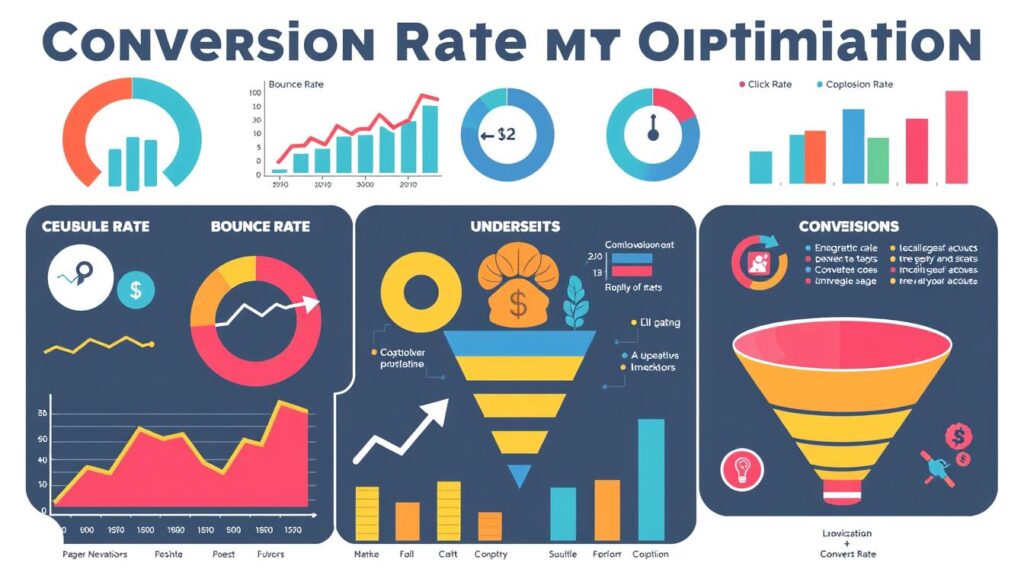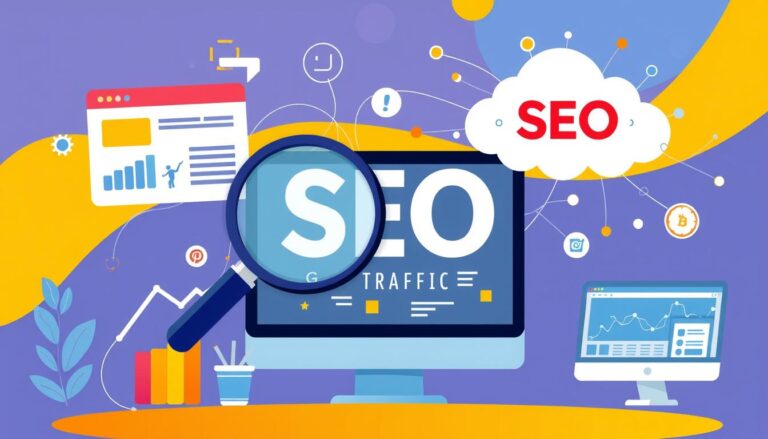Conversion Rate Optimisation: Maximize Your Online Conversions
Digital entrepreneurs face many challenges in turning website visitors into valuable customers. Conversion rate optimization (CRO) is a strategic way to improve website performance and increase online conversions. By studying user behavior and making targeted improvements, businesses can greatly increase their digital success.
Your CRO strategy is about knowing how users interact with your digital platform. It’s about making experiences that encourage users to take the actions you want. With the average ecommerce conversion rate between 2.5% and 3%, smart businesses know how important it is to keep optimizing.
Good conversion rate optimization is more than just tweaking your website. It needs a deep understanding of user psychology, technical performance, and making decisions based on data. This way, you can create digital experiences that turn visitors into customers.
Table of Contents
Understanding Conversion Rate Fundamentals
Conversion rate optimization (CRO) is key for digital businesses wanting to do better online. It helps you understand how well your website works.

Conversion rates show how many visitors do what you want them to. This could be buying something or signing up for a newsletter.
What Defines a Conversion Rate
To find a conversion rate, divide the number of conversions by total visitors. Then, multiply by 100. For example:
- 100 visitors
- 10 purchases
- Conversion rate: 10%
Industry Benchmarks and Standards
A 2023 survey by Ruler Analytics found the average conversion rate is 2.9%. This is a key number for website analytics.
| Industry | Average Conversion Rate |
|---|---|
| SaaS | 10% |
| E-commerce | 2.5% |
| B2B Services | 3.5% |
Key Metrics That Matter
To understand user behavior, track these conversion metrics:
- Total conversions
- Number of visitors
- Conversion rate percentage
- Bounce rates
- Average time on page
“Your conversion rate is not just a number—it’s a reflection of how well your website speaks to your audience.”
By keeping an eye on these metrics and making improvements, you can make your website more engaging and effective.
The Science Behind Conversion Rate Optimisation
Conversion rate optimization (CRO) is a detailed method that explores user psychology and behavior. It turns website interactions into a science, helping you see how visitors use your site.

Good CRO starts with knowing how people make decisions. By using data to understand user actions, businesses can create experiences that lead visitors to take the actions you want.
“Understanding user behavior is the key to unlocking conversion potential.” – Digital Marketing Experts
- Analyze click patterns and user interactions
- Study scroll depth and engagement metrics
- Utilize heat maps for visual behavior tracking
- Investigate cognitive biases impacting decisions
Good behavioral analysis looks beyond just numbers. It digs into what drives users, uncovering the psychological factors that shape their online actions.
| CRO Method | Key Insights | Potential Impact |
|---|---|---|
| Heat Map Analysis | User Click Patterns | Improved Page Design |
| A/B Testing | Comparative User Responses | Higher Conversion Rates |
| User Journey Mapping | Interaction Touchpoints | Streamlined Experience |
By using smart CRO strategies, you can turn your website into a dynamic space that meets user needs and preferences.
Essential Elements of High-Converting Landing Pages
Creating a powerful landing page is an art that mixes smart design with a great user experience. Your landing page is the key to turning visitors into customers. Every detail matters in making your page work well.
Successful landing pages have many important parts that work together to get more conversions. Let’s look at the key elements that make a page great at converting visitors.
Crafting Compelling Headlines and Value Propositions
Your headline is the first thing potential customers see. Research shows that clear, direct language can really help. Here are some tips for making great headlines:
- Use specific, benefit-driven language
- Highlight unique selling points
- Create a sense of urgency
Strategic Call-to-Action Design
CTA design is key to getting users to take action. Studies show that making CTA buttons better can increase conversions by up to 28.76%. Here are some things to think about:
- Use contrasting colors
- Implement action-oriented text
- Ensure appropriate button size
“Your call-to-action is the bridge between interest and conversion.” – Digital Marketing Expert
Visual Hierarchy and Design Principles
The look of your landing page is very important. It can make or break how users feel. Here are some design elements to consider:
| Design Element | Impact on Conversion |
|---|---|
| Mobile Responsiveness | Critical for capturing mobile traffic |
| Social Proof | Builds trust and credibility |
| Visual Content | Increases engagement by 38.6% |
Remember, continuous testing and optimization are crucial for better conversion rates. Each element should be carefully made to guide visitors to your desired action.
Data-Driven Testing Strategies
To boost your website’s performance, you need a smart plan. A/B testing is a key method to learn more about how users act. It helps make your digital marketing better.
Good testing plans include several steps. They help you make smart choices:
- Find important parts of your website to test
- Make different versions of those parts
- Split your website’s visitors into groups
- Track how well each version does
- Look at the results to see if they’re significant
Multivariate testing is even more advanced. It looks at many things at once. Tools like Optimizely, VWO, and Convert help you run these detailed tests.
“Data-driven decisions eliminate guesswork and transform website performance.” – Digital Marketing Experts
It’s important to understand statistical significance. Even small changes can make a big difference. For example, changing a call-to-action button’s color can boost conversions by up to 21%.
| Testing Method | Key Benefit | Complexity |
|---|---|---|
| A/B Testing | Compare two webpage versions | Low |
| Multivariate Testing | Analyze multiple variables | High |
| Conversion Tracking | Monitor performance metrics | Medium |
Keep testing and improving. This way, you turn guesses into solid strategies. These strategies will boost your conversion rates.
User Experience and Website Performance
Your website’s performance affects how users engage and convert. Understanding the connection between user interface and navigation can boost your online presence. It also helps drive meaningful interactions with potential customers.
Successful digital strategies focus on user experience through performance optimization. Let’s look at key areas to improve your website’s effectiveness:
Site Speed Optimization
Page load time is crucial for keeping users. Studies show websites that load slow can lose up to 70% of potential customers. Fast-loading pages make a good first impression and lower bounce rates.
- Leverage Google PageSpeed Insights for performance analysis
- Compress image and multimedia content
- Minimize complex JavaScript and CSS scripts
- Utilize content delivery networks (CDNs)
Mobile-First Design
Mobile responsiveness is a must. With more people browsing on mobile, your site needs to work well on all devices. A mobile-first design ensures your site looks and works great everywhere.
- Implement responsive design frameworks
- Create touch-friendly navigation elements
- Optimize form fields for mobile interaction
- Test across multiple device sizes and types
Intuitive Navigation and Information Architecture
Good website navigation makes it easy for users to find what they need. Clear, logical structures help reduce friction. This makes information easy to find and encourages conversions.
“Simplicity is the ultimate sophistication in user experience design.” – Steve Jobs
Creating clear menus and logical content categorization is key. Also, having user-friendly search functionality that meets visitor needs is important.
Creating Effective Sales Funnels
Building a strong conversion funnel is key to guiding potential customers. It starts with knowing how they move from awareness to buying. This is the first step in optimizing your sales process.
The modern customer journey needs a smart approach. Gone are the days of cold calling. Now, content marketing engages buyers in a more natural way.
“A well-designed sales funnel is like a GPS for your customers’ buying experience.”
What makes a conversion funnel effective? It includes:
- Targeted content for each buyer stage
- Clear call-to-action points
- Personalized lead nurturing
- Streamlined checkout processes
Different content works best at different stages. Blog posts build brand awareness. Customer testimonials seal the deal. About 46 out of 1,000 website visitors buy, showing the funnel’s importance.
A/B testing is vital for improving your funnel. Try different designs, colors, and messages to boost conversions and lower cart abandonment.
A good sales funnel guides, not pushes. It helps customers through a journey that meets their needs and solves their problems.
Analytics and Tracking Implementation
Good conversion rate optimization needs strong web analytics and accurate tracking. Turning raw data into useful insights is key to a successful digital strategy.
Using detailed tracking tools lets you explore user behavior. You can see how visitors interact with your digital sites.
Setting Up Conversion Goals
It’s important to set clear conversion goals. Your goals should be:
- Specific and measurable
- Aligned with business objectives
- Trackable through analytics platforms
Implementing Tracking Tools
Choose strong conversion tracking tools for deep insights. Google Analytics is a top choice for many, offering detailed user engagement metrics.
“Data is the new oil. It’s valuable, but if unrefined, it cannot really be used.” – Clive Humby
Analyzing User Behavior Data
Good user behavior analysis looks at key metrics. Important data points include:
- Click-through rates
- Time spent on page
- Conversion funnel progression
- Exit page identification
Pro tip: Focus on understanding user journey patterns rather than getting overwhelmed by raw numbers.
Conversion rates usually range from 1% to 4%. But with smart tracking and optimization, you can boost these numbers. Keep testing and improving to get better digital results.
Personalization and Customer Journey Mapping
To change your digital strategy, you need to know about personalized content and segmenting customers. Today’s businesses see behavioral targeting as key to meeting user preferences.
“Personalization is not about first/last name. It’s about relevant content.” – Dan Ndoye
Creating a great customer journey involves several steps:
- Analyze customer interaction data
- Create detailed user personas
- Implement dynamic content strategies
- Continuously refine personalization techniques
Personalization is powerful. Studies show segmenting your audience can boost revenue by up to 760%. Companies using AI for journey mapping see big wins in customer engagement and keeping customers.
| Personalization Metric | Impact Percentage |
|---|---|
| Revenue Increase | 760% |
| Customer Retention | 30% |
| Customer Satisfaction | 20% |
By knowing what each customer likes, you can make experiences just for them. AI tools spot problems and help customers move smoothly from looking to buying.
Good personalization isn’t about too much. It’s about giving customers what they need, when they need it. This makes their experience meaningful and relevant.
Conclusion
Conversion Rate Optimization (CRO) is a key way to boost your online presence. By using the right CRO strategies, you can see big growth in your business. Even small changes can lead to doubling your leads and customers without spending more on marketing.
Keeping up with optimization is key for lasting success online. Improving ROI starts with knowing how users behave and making your site easy to use. Making smart choices based on data helps you stay ahead and keep your site user-friendly.
The online world changes fast, so being open to new CRO ideas is crucial. Always test, analyze, and adjust to keep up with what users want. Remember, optimizing your site is a continuous journey, not a one-time fix.
Stay committed to finding new CRO methods and using advanced analytics. Focus on giving your visitors the best experience. This dedication will lead to more conversions, stronger customer ties, and business growth.







